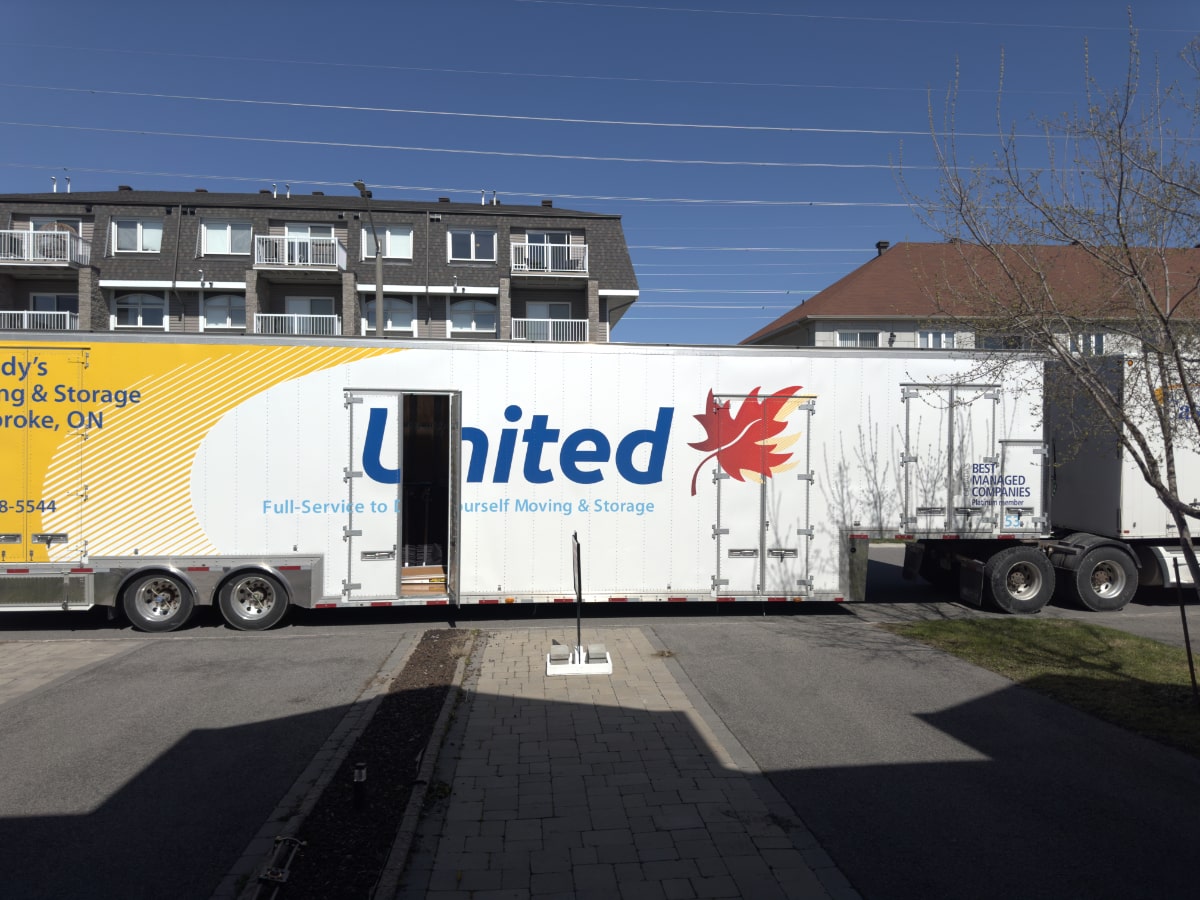Table of Contents
Thinking about moving from Ottawa to a new city, province, or even another country?
In the two years leading up to 2021, 2.1 million (13.8% of 15 million) Canadian households moved and recent statistics show long distance moves are actually on the rise, with many finding new opportunities across the country and beyond.
Moving long distance is no walk in the park, and tackling it without a plan can quickly become a huge disaster. Planning ahead isn’t just smart—it’s essential. Whether you’re heading to a historic neighbourhood of Montreal, a scenic village in British Columbia, or the sun-soaked beaches of Florida, having a detailed plan can mean the difference between a smooth transition and a logistical nightmare.
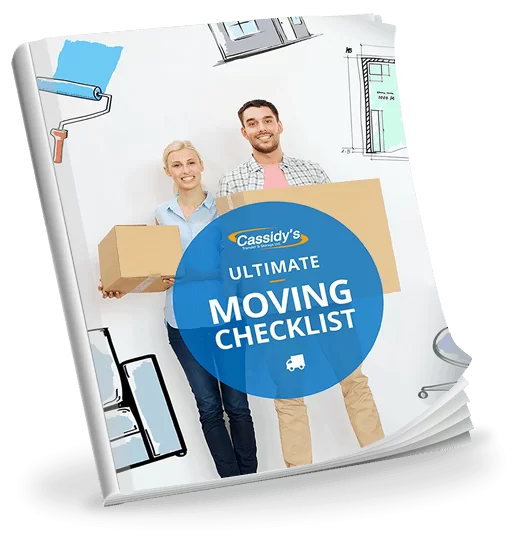
Free Ultimate Moving Checklist
Say goodbye to moving stress with our 2023 residential moving checklist for Canada—it’s the ultimate time-saver!
Download NowBut don’t sweat it—we’ve got your back during this crazy long distance moving process. This moving guide will walk you through everything you need to know to make your cross country move the stress-free adventure it should be.
1. Initial Planning
a. Find The Right Professional Moving Company

The first step in your long-distance move is finding professional movers you can trust. This isn’t a time to gamble on your cousin’s friend who owns a truck. You need professionals. Start by researching and reading reviews. Look for long distance moving companies with solid reputations and glowing testimonials. Don’t settle for the first quote you get; compare prices and services to ensure you’re getting the best deal.
If you’re moving long-distance from Ottawa to another city, get a custom quote from Cassidy’s – Ottawa’s trusted moving company and check our Google reviews!
Check out this comparison of renting a U-Haul vs hiring a moving company for more insights.
b. Budgeting for Your Cross Country Move

Long-distance moves can quickly become pricey, but a well-planned budget can keep moving expenses in check. Think about everything you’ll need and write it down: storage, the number of professional movers, packing supplies like boxes, tape, and bubble wrap—it will add up quickly. Other costs might include packing services, insurance, special handling for items that require it like pianos or antiques, and transporting you and your family.
Make a spreadsheet and create a budget that accounts for every cost, so you won’t be taken by surprise and go over budget.
To cut down on costs, consider picking a moving date on a weekday or during off-peak season (October to April) when rates are usually cheaper. Sell possessions you don’t really need (like that couch you’ve been thinking of replacing) to lower the amount of boxes that need to move with you.
If you think you’ll need storage, Cassidy’s Sea Can (Shipping Container) Rentals offers flexible and secure options. You can rent or buy new and used shipping containers or get climate-controlled storage in our warehouse for your home or business.
Also: Learn more about renting vs. buying storage containers.
c. Research & Plan
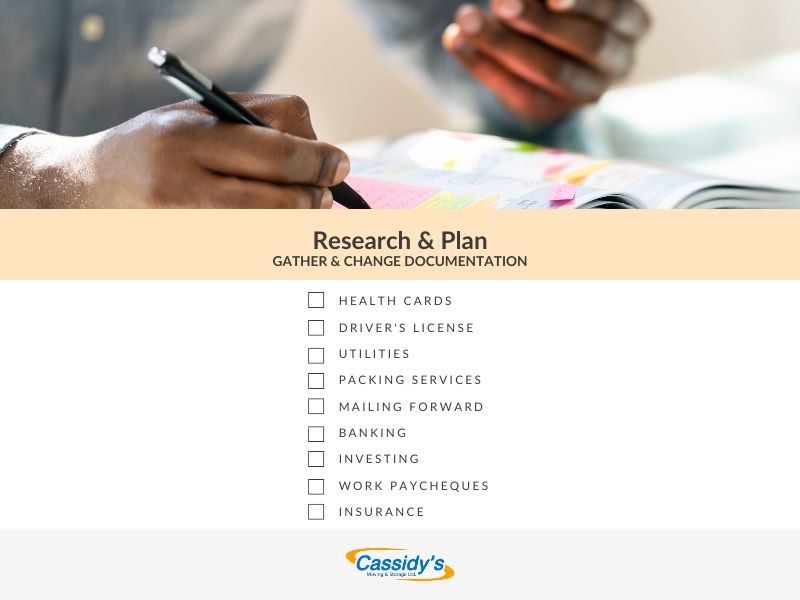
It’s time to know exactly what you’re getting into. Before you move, find and gather all your documents and files in one place and keep them handy. This includes identification, contracts, insurance papers, and any permits you might need for your new location. Make photocopies. Learn and understand the rules and regulations of your new province or country, including any documentation you’ll need for your family and pets.
It’s also a good idea to research your new city. Figure out where your bank is, the local schools, grocery store, gym or recreation centre, and learn about transportation.
Plan out the logistics of the move itself. Create a detailed moving plan that outlines every step, from packing to the actual moving date. Also read: Hiring movers vs moving yourself.
Finally, type up a cross country moving checklist and make sure you don’t miss anything else you need to do before you leave. This can include cancelling utilities, updating your address with important institutions, having mail forwarded, and booking hotels if needed. By planning ahead, you can minimize stress and make your long distance move as easy as possible.
2. Preparing for the Move
a. Decluttering and Organizing
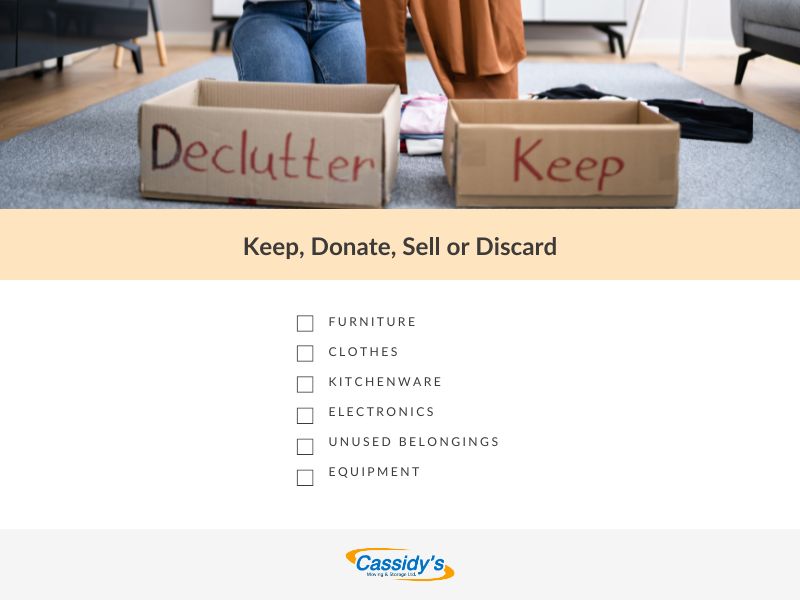
Moving is the perfect time to declutter. Why pack and haul stuff you don’t need? Be ruthless—if you haven’t used it in a year, it’s probably time to let it go. Furniture, clothes, and sports equipment all tend to accumulate over time. Organize your belongings by sorting items into categories: keep, donate, sell, or discard. This will make your packing so much easier and also lower your moving costs.
b. Creating a Moving Inventory
An inventory list isn’t just for control freaks—it’s a lifesaver. Use one to keep track of all your possessions and help with insurance claims if anything gets lost or damaged. There are online tools or apps to create and manage your inventory efficiently, but even a simple Google spreadsheet will work. Knowing exactly what you have and where it’s going can save you a lot of headaches down the road.
3. Packing Tips
a. Gathering Moving Supplies
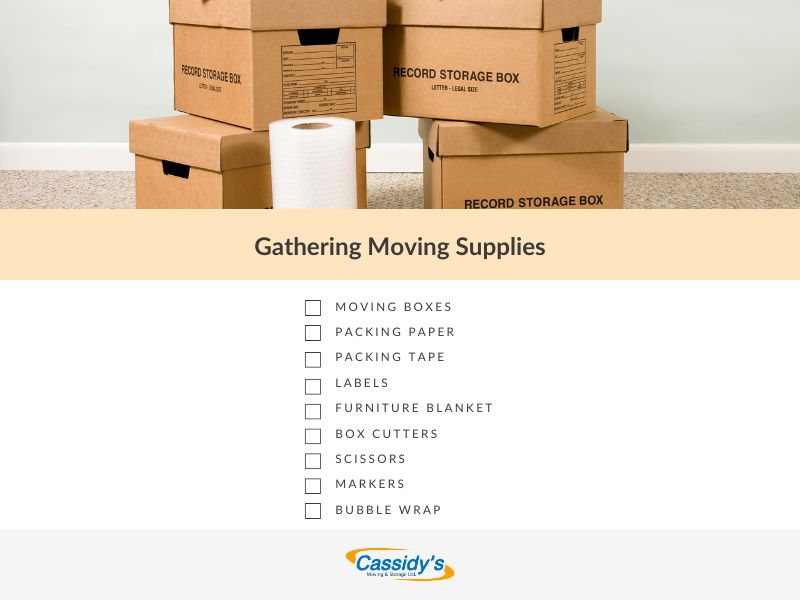
Don’t start packing until you have the right materials. You’ll need boxes, tape, markers, and bubble wrap. For the environmentally conscious, eco-friendly options are out there like reusable containers and biodegradable packing materials.
Investing in real moving boxes and packing tape can help prevent damage to your belongings. Moving boxes also come in standard sizes, making them a lot easier to stack and load into a moving truck without having to play Tetris. You can find specialized boxes for fragile items like dishes and electronics.
Labels and markers are also essential for an organized move. Clearly labelling each box with its contents and designated room will save you time and hassle during the unpacking process. Colour-coded labels can also help with staying organized.
Lastly, having scissors, box cutters, and furniture blankets will make your packing process much smoother. By getting all of this ahead of time, you’ll pack more efficiently, have less frustration, and make sure your belongings are protected during the move.
b. Packing Strategies
Don’t just start shoving things into boxes! Have a packing strategy. Start by packing one room at a time. This method helps you stay organized and makes unpacking easier. Begin with the least-used rooms, such as guest bedrooms or storage areas, and save everyday essentials for last.
Give yourself time. For the average 3-bedroom home, you could spend 3-4 full days packing.
Clearly label each box with its contents and the room it belongs to in your new home. Categorizing boxes can make unpacking easier and more efficient. This methodical approach prevents chaos and makes settling in smoother.
Use the right-sized boxes for different items. Heavy items like books should go in small boxes, while lighter items such as linens and pillows can fill larger ones. This not only makes moving the boxes easier but also prevents overpacking and potential damage.
Flammable, explosive, and other chemical products should not be packed for moving.
Wrap fragile items individually with bubble wrap or packing paper. Place heavier items at the bottom of the box and lighter ones on top. Fill any empty spaces with packing peanuts or crumpled paper to prevent shifting during transit. Clearly label each box with its contents and the room it belongs to. Colour-coded labels or markers can add an extra layer of organization, making it easier to find what you need quickly.
4. Moving Day
a. Final Checks
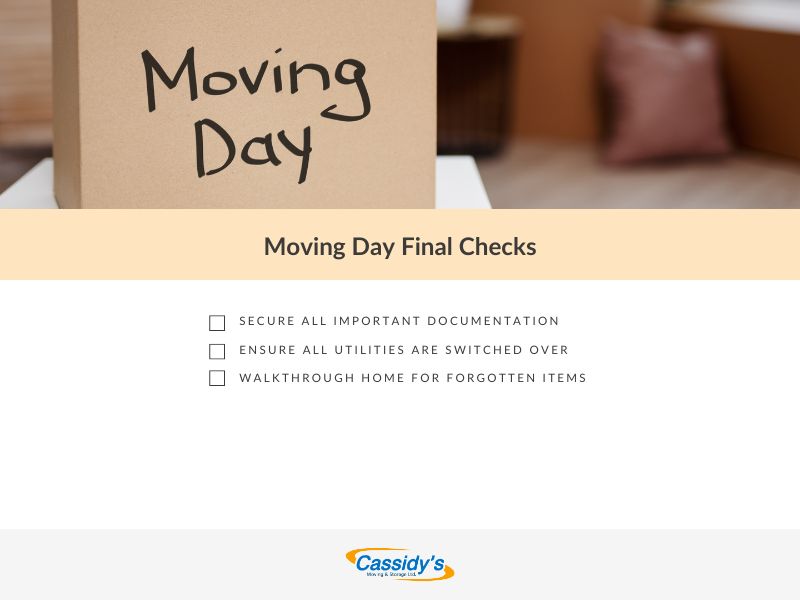
Before you hit the road, double-check everything. Make sure all utilities and services have been transferred or scheduled to be disconnected. This includes electricity, water, gas, internet, and any other essential services.
Do a thorough walkthrough and make sure nothing is left behind. Check all closets, cabinets, drawers, and storage areas. It’s easy to overlook small items or those tucked away in less obvious places.
Keep anything you might need immediately upon arrival in a secure, easily accessible place. Things like keys to your new place, bank cards, identification, financial documents, and medical records.
b. Managing Moving Day
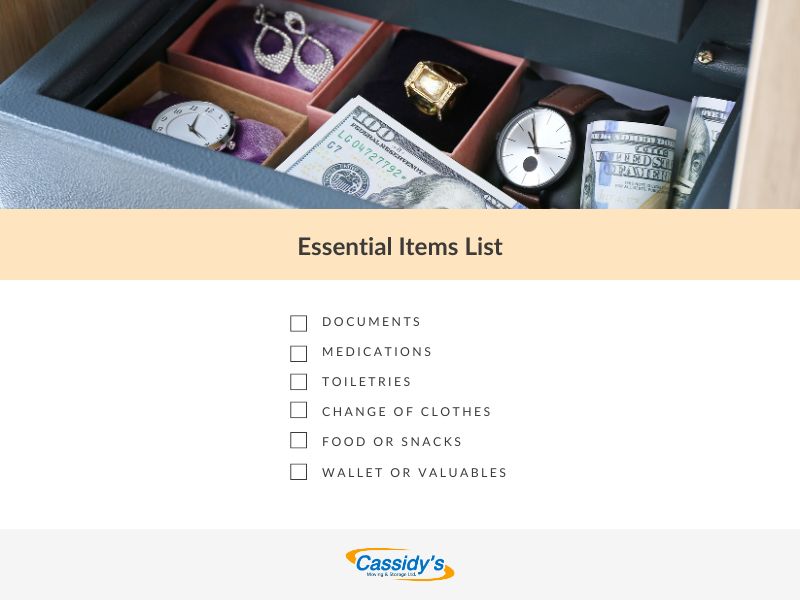
It’s your moving date, but staying organized will keep you calm and in control. Start the day early to maximize daylight and allow for any unexpected delays. Have a detailed plan and timeline, including when professional movers will arrive, loading schedules, and travel times. Keep a copy of this plan handy and share it with everyone involved.
Ensure that you have essential items you’ll need easily accessible, such as important documents, medications, toiletries, and a change of clothes. Pack these in a backpack or something you can keep with you. It’s also wise to have snacks, water, and basic tools (like screwdrivers and box cutters) readily available.
Keeping a running checklist of tasks to complete throughout the day. Check off items as they are loaded onto the truck to ensure nothing is left behind. Be present and available to direct movers, answer questions, and manage any last-minute issues.
For families with small children or pets, arrange for a sitter or designate a safe, quiet area for them to stay during the hustle and bustle. This will help reduce stress for both them and you.
Do a final walkthrough to make sure nothing is left behind. Double-check that all doors and windows are locked before you leave.
Finally, be prepared for the unexpected. Delays, traffic, or last-minute changes can happen, so maintain a flexible mindset and keep your stress levels in check. By staying organized, communicative, and prepared, you can manage moving day efficiently and set the stage for a smooth transition to your new home.
5. Settling In
a. Unpacking Efficiently
Unpacking doesn’t have to be a nightmare! Take your time and enjoy the process of setting up your new space.
Begin by unpacking boxes of items you use regularly, such as cooking utensils, toiletries, and bedding. This will help you gain a sense of normalcy in your new place.
Use the labels on your boxes to guide you, and put each box in its designated room before unpacking them. This will minimize confusion. As you unpack, place items directly into their intended spots rather than piling them on the floor. This method keeps your new home organized from the start and reduces the need for searching later on.
Break down unpacking into manageable tasks. Instead of trying to tackle everything at once, set small goals, like completing one room or unpacking a set number of boxes each day. This will stop you from getting overwhelmed and procrastinating and will keep you motivated.
Get rid of packing boxes and materials quickly to keep your space clutter-free. Flatten boxes for recycling and organize packing supplies you may want to reuse.
Finally, take your time personalizing your new space. Arrange furniture and have fun decorating, making your new house feel like home. These steps will take most of the stress out of unpacking.
b. Making Your New House a Home
It’s time to make your new place feel like home sweet home. Set up your internet, utilities, and security systems as soon as possible. Start to make your space feel familiar and like it’s yours. Exploring your new neighbourhood and connecting with your neighbours and community can also help you settle in more comfortably.
Begin with the rooms you use most, such as the living room and bedroom. Arrange furniture in a way that makes you enjoy being there. Adding personal touches like family photos, artwork, plants, and decorations can make the space feel more familiar and inviting.
Finally, give yourself time to adjust. Moving is a significant change, and it’s okay to take it step by step. By gradually adding your personal touches and integrating into your new community, your house will soon feel like home.
Work With Cassidy’s For Your Long Distance Move
Long distance moving is a big deal, but with the right plan, it doesn’t have to be a headache. Start early, stay organized, and let the pros handle the heavy lifting.
Ready to make the leap? Request a quote from Cassidy’s and start your new adventure with confidence.
